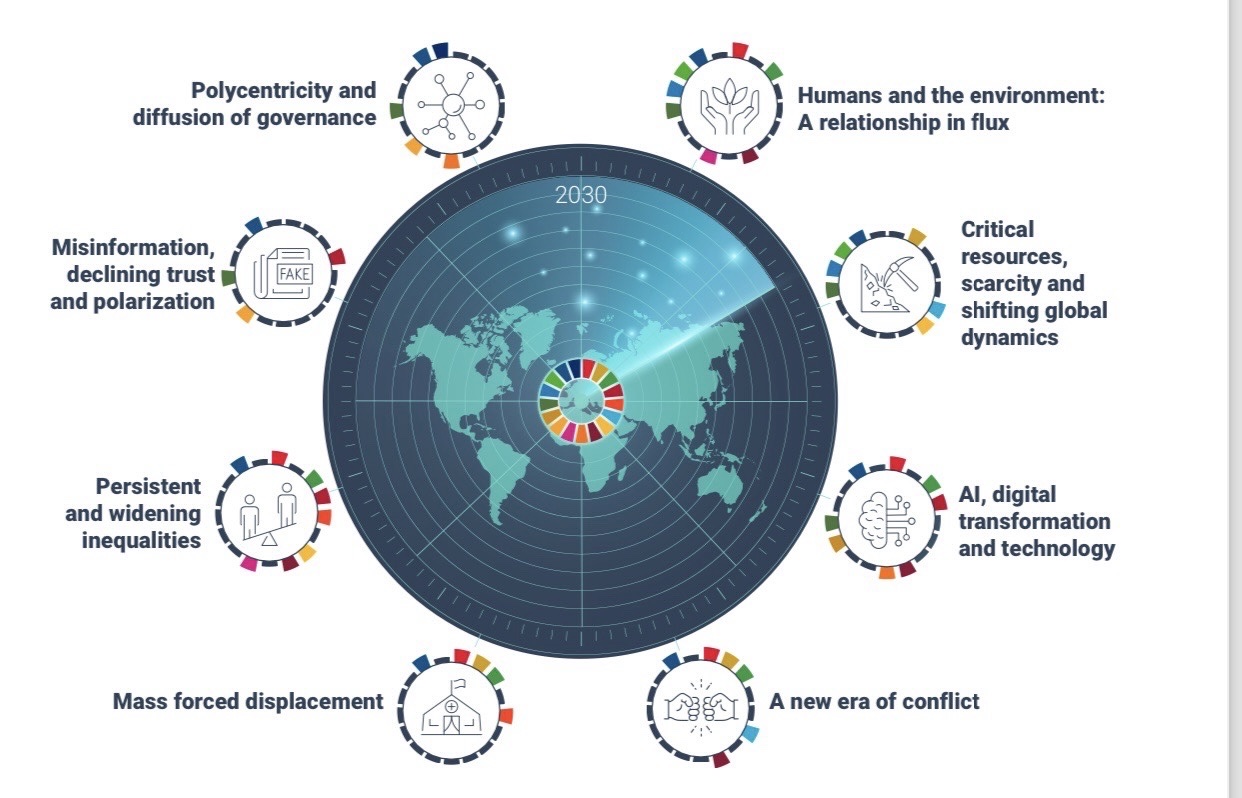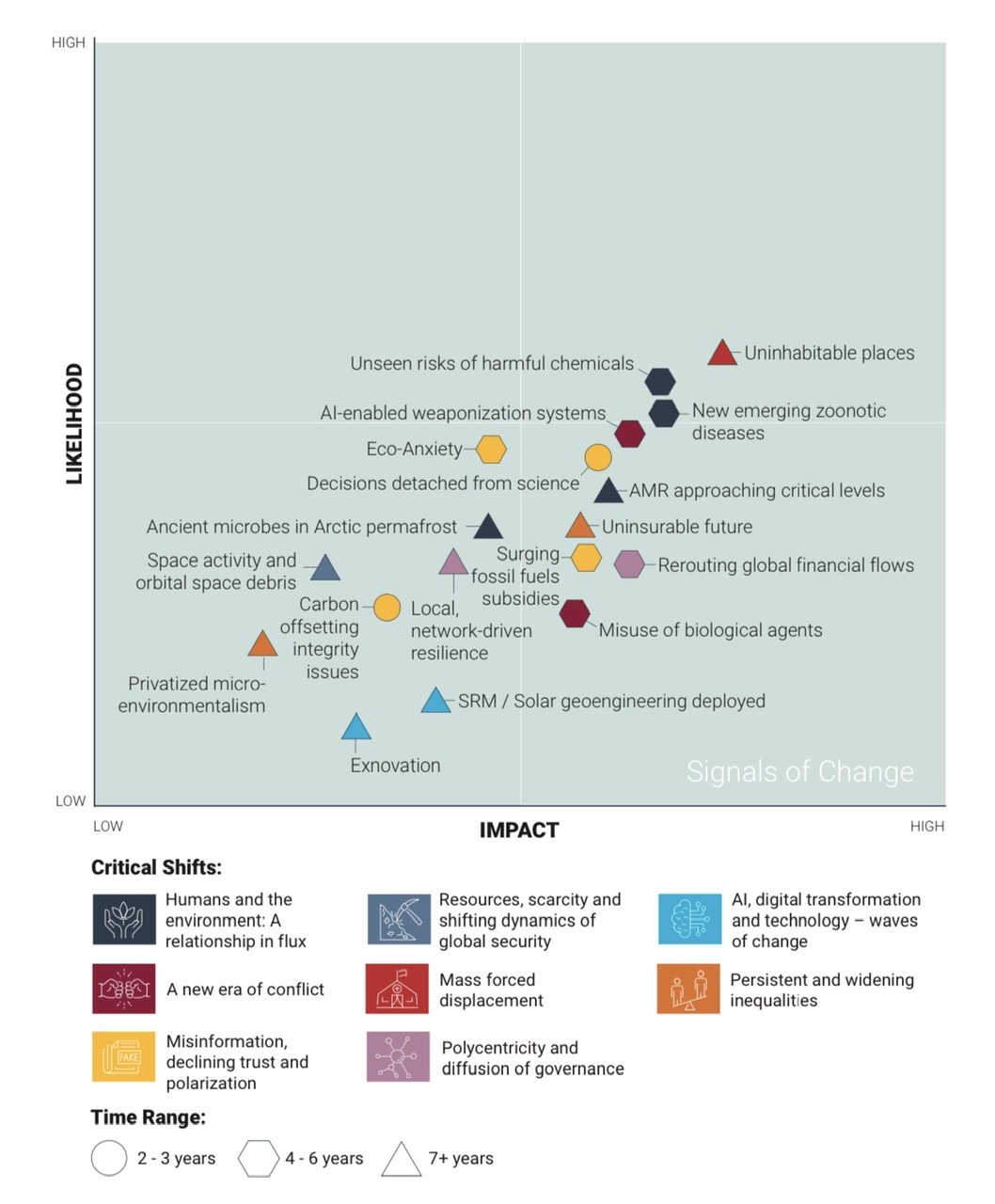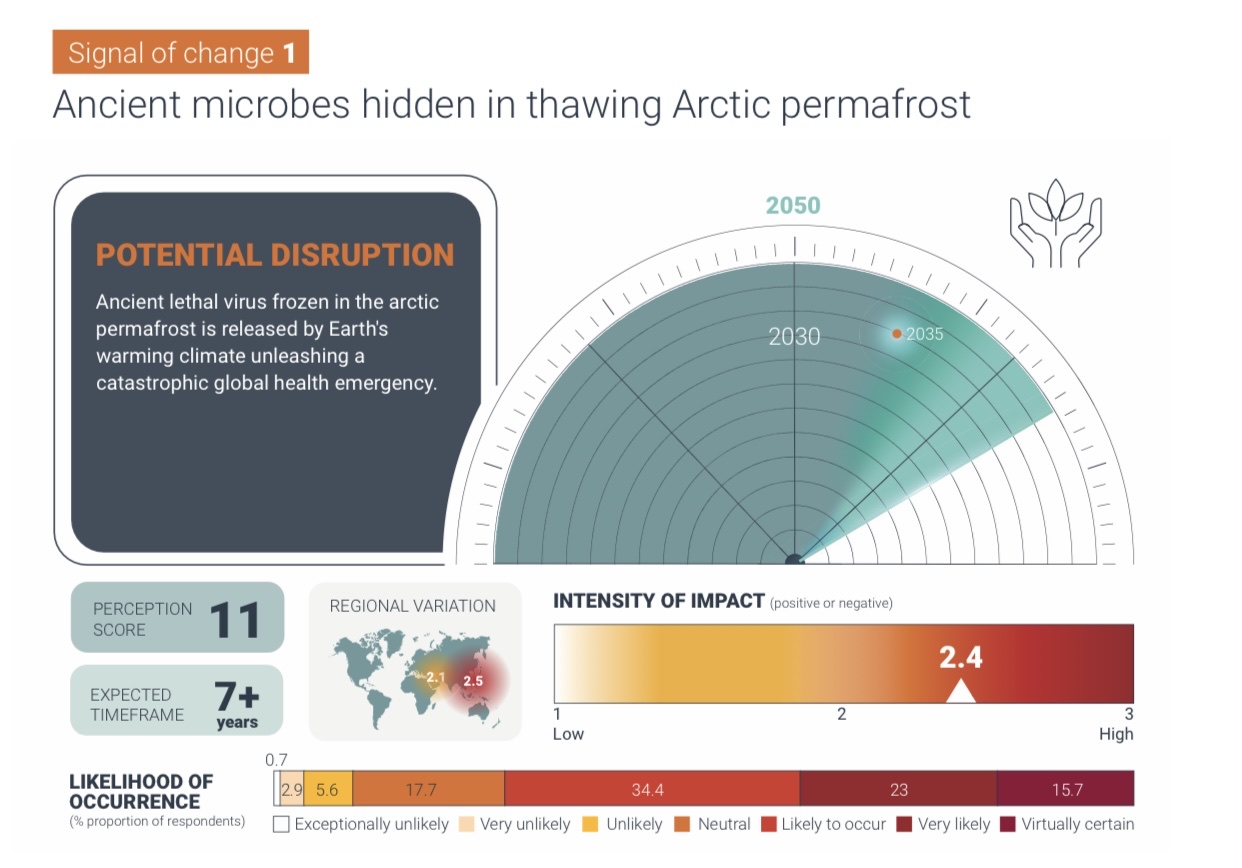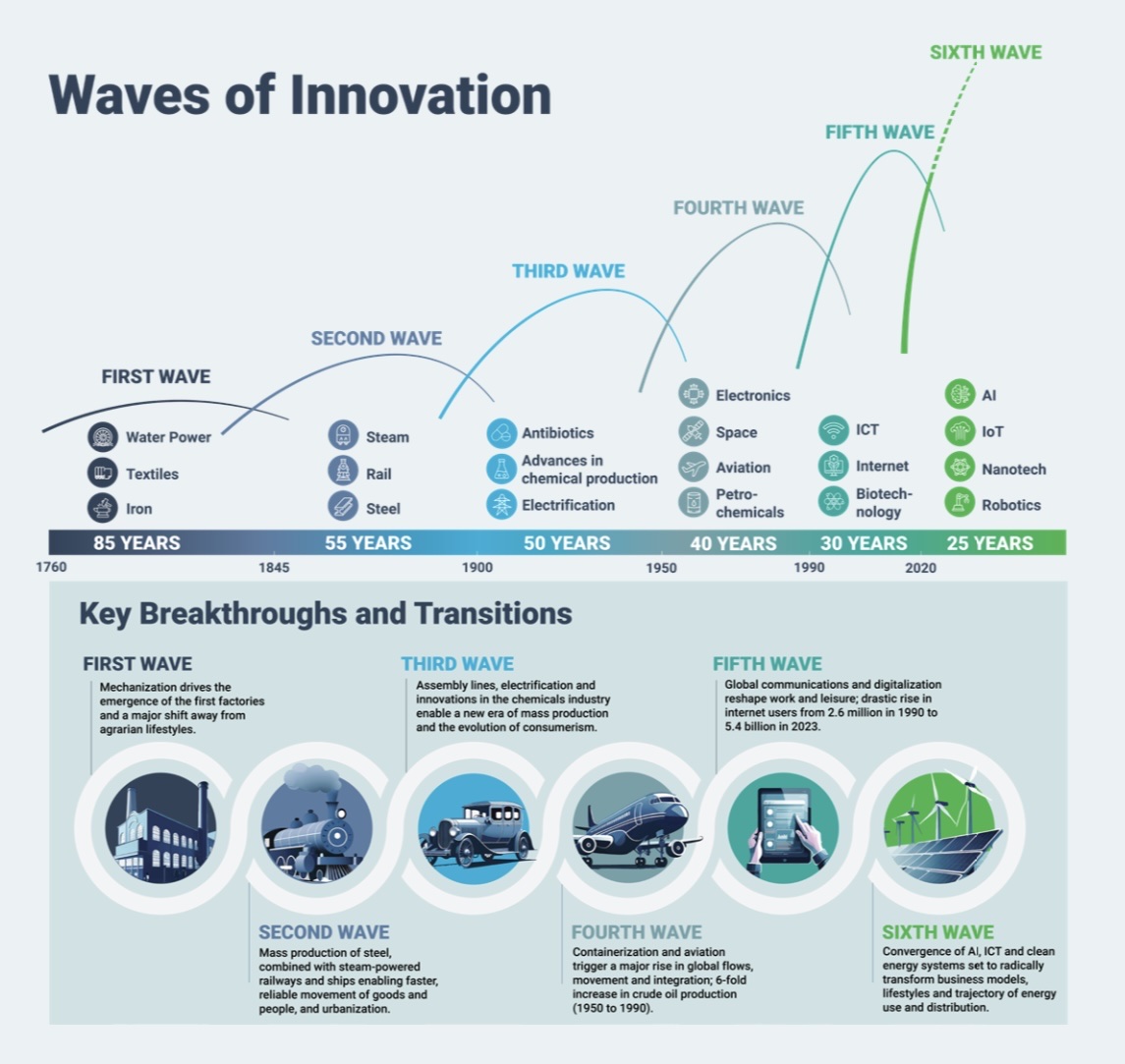

03/01/2025
This report from the United Nations Environment Programme (UNEP) and the International Science Council (ISC) shows why the world must get better at tracking and responding to a host of emerging challenges as environmental, technological and societal change join forces to disrupt human and planetary health. This report identifies eight critical global shifts that are accelerating the triple planetary crisis of climate change, nature and biodiversity loss, pollution and waste.
The institutionalized approach to strategic foresight and horizon scanning
To help navigate current and future uncertainty and disruptive change, while effectively delivering on its mandate, UNEP has been implementing an institutionalized approach to strategic foresight and horizon scanning with the view to developing an anticipatory and future-oriented culture. This mirrors the growing interest and demand for foresight that is also reinforced by the United Nations reform agenda and the Secretary-General’s report on “Our Common Agenda”, which calls for all UN agencies, as well as all UN member states, to engage foresight practices more deeply and apply the derived insights to address global systemic risks.
This process has culminated in the development of the present report “Navigating New Horizons – A global foresight report on planetary health and human wellbeing”, produced by UNEP in collaboration with the International Science Council. The report calls for the world to pay heed and respond to a range of emerging challenges that could disrupt planetary health and wellbeing. It presents insights on eight critical global shifts that are accelerating the triple planetary crisis of climate change, biodiversity and nature loss and pollution and waste.
Eighteen signals of change identified by hundreds of global experts and distilled through regional and stakeholder consultations that included youth offer a glimpse into potential disruptions, both positive and negative, which the world needs to keep a watching brief on (Figure 1). The report outlines how to create an enabling environment for better decision-making by creating a new social contract, embracing agile and adaptive governance, and increasing integrated accessible data and knowledge.

Figure 1: Eight critical global shifts or phenomena that emerged from the foresight process
Source: Navigating New Horizons
The report offers a stark reminder of the interconnectedness and fragility of our systems in the 21st century and warns that prioritizing short-term gains over anticipatory action and preparedness jeopardizes long-term prosperity and planetary health. However, it also points to the tremendous potential and human ingenuity that can be leveraged in the spirit of discovery and cooperation to deliver solutions across the triple crisis.
The outcomes of the report will be integrated into UNEP’s strategic planning, potentially influencing the next UNEP MTS, presenting an opportunity to consider expanding programmes in areas like artificial intelligence, new technology, and robotics in agriculture, prompting discussions on the level of engagement in these issues. This will ultimately serve UNEP in adopting a proactive posture and modernize tools for efficiency and cost savings.
Furthermore, the report will serve as UNEPs contribution to the Summit of the Future. While it is not expected to substantively influence the Summit of the Future as such, it will serve to provide inputs into the preparatory discussions and events, including the High-level Political Forum, in the lead-up to the Summit of the Future as they relate to environmental dimensions.
Critical shifts and signals of change
Each of the eight critical shifts identified during the process are outlined below together with associated signals of change. They have a lower probability of occurrence and are possibly unintended but have significant potential to disrupt if they eventuated. The signals of change are not necessarily positive or negative, but simply early symptoms or indicators of a future development with potential to grow in scale and distribution (Figure 2).

Figure 2: Eighteen signals of change and potential disruptions depicted along three dimensions: likelihood, impact and time horizon.
Source: Navigating New Horizons
A synopsis has also been provided of the most acute potential disruptions on the horizon for each signal of change, which could significantly influence planetary health and wellbeing. They need to be kept on the radar to observe their direction, character and strength before they develop into stronger trends. Monitoring signals on the horizon provides information to mute signals that have the potential to disrupt negatively, but also amplify those that will accelerate positive change. (Each of the eight critical shifts identified during the process are outlined below together with associated signals of change). They have a lower probability of occurrence and are possibly unintended but have significant potential to disrupt if they eventuated. The signals of change are not necessarily positive or negative, but simply early symptoms or indicators of a future development with potential to grow in scale and distribution. Monitoring signals on the horizon provides information to mute signals that have the potential to disrupt negatively, but also amplify those that will accelerate positive change.
The shifts include humanity’s degradation of the natural world, the rapid development of technologies such as AI, competition for natural resources, widening inequalities and declining trust in institutions. These shifts are creating a polycrisis, in which global crises are amplifying, accelerating and synchronizing with huge implications for human and planetary wellbeing.
Eighteen accompanying signals of change identified by hundreds of global experts through regional and stakeholder consultations that included youth offer a deeper glimpse into potential disruptions, both positive and negative, that the world must prepare for.
“As the impacts of multiple crises intensify, now is the time to get ahead of the curve and protect ourselves from emerging challenges," said UNEP Executive Director Inger Andersen. “The rapid rate of change, uncertainty and technological developments we’re seeing, against a backdrop of geopolitical turbulence, means any country can be thrown off course more easily and more often. By monitoring signals of change and using the foresight approach outlined in this report – including looking outside the traditional environmental space – the world can avoid repeating mistakes of the past and focus on solutions that can withstand future disruption.”
Key shifts and signals of change outlined in the report include:
The demand for critical rare earth elements, minerals and metals to fuel the transition to net-zero is expected to increase fourfold by 2040, increasing calls for deep sea mining and even space mining. This poses potential threats to nature and biodiversity, could increase pollution and waste, and spark more conflicts.
While AI and digital transformation can bring benefits, there are environmental implications – such as increased demand for critical minerals and rare earth elements and water resources to meet data centre demands. The use of AI in weapons systems and military applications, and the development of synthetic biology, need careful review through an environmental lens.
Armed conflict and violence are rising and evolving. These conflicts result in ecosystem degradation and pollution, leading to repercussions for vulnerable populations.
Forced displacement is increasing human health and environmental impacts. One in every 69 people is now forcibly displaced – nearly double the figures from a decade ago. Conflict and climate change are key drivers.
Each of the signal of change images summarize the information gathered during the learning phase for each identified signal of change in the foresight process. They provide a concise description of the potential disruption and their percieved likelihood of occurrence and severity.

Figure 3: Ancient microbes hidden in thawing Artic permafrost
Source: Navigating New Horizons
Adopting foresight
However, the report finds that using foresight tools can help the world to anticipate and prepare for the next emerging challenges and future disruptions. Peter Gluckman, President of the ISC, said, “Foresight provides a useful set of tools to step outside of short-termism to help identify future opportunities and risks provided that it is done in a truly pluralistic manner, transcending narrow institutional mandates, sectors and other artificial divides that constrain our framing of the problems and the solutions.”
The report recommends adopting a new social contract that engages a diverse range of stakeholders, including indigenous people; giving young people a stronger voice; and rethinking measures of progress to go beyond GDP.
Governments and societies can also introduce shorter term targets and indicators that allow them to be more agile in governance. Ushering in tools and actions to reconfigure financial systems and reroute capital flows, a positive signal of change in the report could help to reduce inequalities, eradicate extreme poverty and address environmental crises.
Supporting agile and adaptive governance would require better monitoring and assessment of interventions. This includes integrating and improving monitoring on environmental change, and making data and knowledge more accessible.
Just as the impacts of multiple crises are amplifying harm to environmental and human health, the solutions are in sight and actions are underway that would address the global shifts and signals of change identified in the report. Foresight can help to accelerate these actions and spark many more.
Managing change and building resilience
This report shows that humanity has a stark and urgent choice to make: continue to destabilise planetary health and risk losing humanity’s life support system, or build a future that embraces equity, addresses the underlying drivers of environmental degradation and achieves sustainable development. What humanity decides now will shape the world that future generations will inherit.
Since the start of industrialisation, successive and accelerating waves of technological innovation have transformed societies and economies globally, radically altering ways of living and working (Figure 4). Scientific and technological breakthroughs have created opportunities and boosted living standards in many regions, and further technological advances will be essential if humanity is to achieve sustainability in coming decades.

Figure 4: Waves of technological innovation
Source: Navigating New Horizons
Embedding these principles and addressing the huge environmental and social challenges ahead will require the voices and knowledge of all society, nationally and globally. This will only be possible if the burdens and opportunities are shared fairly, and if youth and other marginalized groups are given a voice. The world needs a new social contract.
From the foresight process, three areas stand out as important opportunities to renew the social contract and increase society’s resilience: engaging and embracing a broader and diverse range of stakeholders including women, indigenous and local peoples; giving young people a stronger voice; and rethinking measures of progress.
Embracing the views of a more diverse group of stakeholders: The active participation of individuals and groups in the decision-making processes that affect their lives is central to social cohesion and trust in government.
Giving young people a stronger voice: Young people will bear the consequences of today’s decisions for decades to come. In some developing regions that are particularly vulnerable to climate change, young people make up a large part of the population. In other regions, smaller youth cohorts face the burden of financing the expanding population of pensioners in many parts of the world. In any event, young people face a difficult inheritance from earlier generations.
A new framework for prosperity: A new social contract would entail a fundamental reimagining of the role of businesses and markets. Current economic systems reward businesses for focusing narrowly on maximizing short-term financial returns for shareholders and externalizing environmental and social harms. Consequently, humanity’s resources and ingenuity are largely invested in activities that cause widespread harm across globalized value chains.
Agile and adaptive governance for a sustainable future: Across many of the signals of change, accelerating change has emerged as a core theme. Communities across the world face more frequent and severe disruptions as the effects of climate change intensify and the interdependence of globalized systems causes localized crises to spread. These changes create opportunities to meet material needs in more sustainable ways. But they also bring risks and uncertainties, potentially jeopardizing privacy and human agency, undermining democratic governance and contributing to conflict.
Guiding governance through data and knowledge: It will be difficult to navigate the challenges ahead without a transformation in the knowledge systems that support governance. Creating and implementing a new social contract requires the creation of open knowledge sharing platforms that empower citizens, as well as new metrics that go far beyond GDP to create a much richer representation of the health of societies and ecosystems. Supporting agile and adaptive governance depends on monitoring and assessing the impacts of innovation, experimentation and systems that enable information to be shared horizontally and vertically to guide investments and actions. But the needs and value of leveraging data and knowledge extend far beyond this.
Nhâm Hiền
(Source: Navigating New Horizons 2024)
(Source: The article was published on the Environment Magazine by English No. IV/2024)